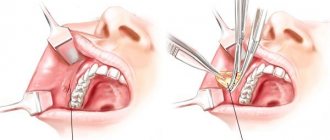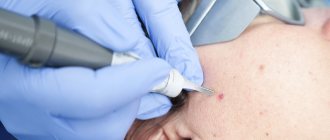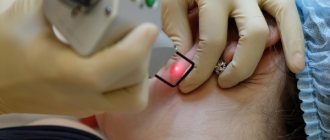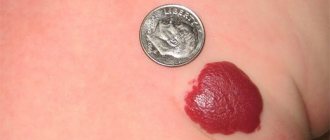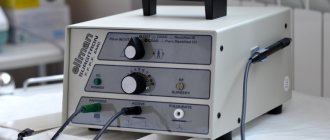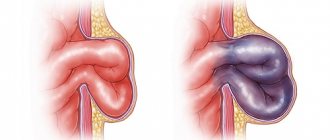- Removing moles with a scalpel with sutures and bandages, nitrogen and electrocoagulation is inexorably becoming a thing of the past. To remove formations up to 1 cm, modern medicine has in its arsenal methods that minimally injure the skin. These methods are laser and radio wave surgery. Here we will not delve into their operating principle. Let’s just note that clinical studies have proven that radio waves have less impact on healthy tissue compared to lasers. This is what allows for rapid healing and minimal likelihood of scar formation.
- Doctors today have a large number of drugs at their disposal that prevent the development of scars. Their combined use in the postoperative period reduces the likelihood of scarring to almost zero.
Currently, a scar after removal of small (up to 1 cm) moles by an experienced doctor is the exception, not the rule.
The essence of the problem
A mole, or nevus, is a benign skin formation. It occurs when the pigment melanin accumulates, in the formation of which the pituitary hormone plays a major role. Given this role of this important element of the endocrine system, it is believed that the appearance of moles is largely determined by hormonal changes. This conclusion is confirmed by the increased formation of nevi in adolescents during puberty, in pregnant women and during menopause. In addition, an increased risk of their occurrence has been established with excessive exposure to sunlight, as well as in people with light skin.
Most often, moles do not pose any danger to human health and remain quietly in their place throughout their lives. People can be irritated by the aesthetic side of the problem, especially when such defects are located on the face and are of significant size. At the same time, nevi are not always so harmless. In some cases associated with exposure to solar ultraviolet radiation or frequent mechanical damage (friction, abrasion), there is a possibility of transformation of moles into a malignant formation with all the ensuing serious consequences.
Thus, in the question of the need to combat such a phenomenon as a mole, there is an alternative. If it does not interfere with life (and many even like such piquant spots) and does not cause emotional distress, then it should be left alone and no measures should be taken. In cases where moles are fraught with danger of both a pathological and psychological nature, you should think about their removal.
Also read what to do after removing papillomas with a laser.
Reason to take action
The decision on the need to remove moles is made for the following main reasons:
- localization on an open area of skin (face, décolleté, etc.), which causes nervous disorders due to disturbances in appearance;
- location in a place where the mole is often subjected to mechanical stress, which causes its damage (especially with bleeding);
- the appearance of signs of malignancy.
Dangerous signs that require urgent medical attention include the following:
- glossy tint and smoothing of the surface of the nevus;
- blurred contour and the appearance of asymmetry;
- rapid increase in size;
- the appearance of itching, peeling or burning;
- wet surface;
- bleeding;
- disappearance of the nevus with the appearance of a new formation in its place.
Sometimes laser removal of warts is required.
Video of laser mole removal:
Laser removal of red moles
Many patients wonder: is it possible to remove red moles? These formations are called angiomas. They are vascular nevi that arise due to improper functioning of the vascular system. They are small red dots growing from blood vessels (arteries, veins, capillaries). All angiomas differ from each other not only in appearance, but also in the depth of their location.
The absolute indication for the destruction of a red mole is its transformation. Most likely, a specialist will advise removing it due to mechanical injury or for cosmetic and aesthetic reasons. Recently, such nevi are removed using a laser.
Formation removal technology
Removing moles on the face or body can be done in different ways. Laser technology is among them in a leading position for a number of reasons. The following advantages contribute to the popularity of this method:
- absence of surgical intervention (non-invasive method);
- only tissues with a changed structure are affected, without damage to neighboring areas;
- almost complete absence of pain and bleeding;
- short postoperative recovery period; small postoperative scars and scars;
- exclusion of relapses;
- the ability of laser radiation to accelerate skin regeneration; no need for hospitalization;
- eliminating the risk of infection, because laser radiation has antiseptic properties.
Here you can learn about laser vein removal.
Laser removal is carried out using special installations. The most commonly used lasers are neodymium, erbium or CO2 lasers. The technology is based on the principle of ablation, i.e. evaporation of abnormally changed cells by directing a focused laser beam at them. The process is carried out by layer-by-layer removal of abnormal tissue on the mole, and the procedure is carried out until a microscopic wound appears.
As a rule, removing a defect requires 1 session, which lasts several tens of seconds. If the nevus is large, several procedures may be performed. In this case, the interval between them is 1-2 weeks.
After each treatment, a solution of potassium permanganate is applied to the affected area, which dries the wound. The removed tissues must be subjected to histological examination to identify malignant cells. Also read about laser hair removal.
Video of laser mole removal on the face:
Anesthesia during the procedure is prescribed only if there is individual hypersensitivity of the skin. In this case, local anesthesia is provided by injection or application of an appropriate cream. The link describes laser removal of stars.
Disadvantages of the method
Some nevi can over time turn from a benign formation into a malignant tumor - melanoma, therefore, to prevent such cancerous tumors, timely histological studies are very important. With laser removal of nevi, it is impossible to analyze the tissue of the removed formation, which is the main disadvantage of this procedure. That is why the laser is used only after laboratory testing of the material taken from the nevus has confirmed its non-malignant nature. Anyone wishing to remove moles using this method must first do the necessary tests and only then proceed with this operation. Without a preliminary histological examination of a mole, it should under no circumstances be removed.
Laser removal of moles on the body
When not to have surgery
The laser method of removing moles is considered a safe and painless non-invasive method. However, it also has certain limitations in use caused by the individual characteristics of the patient’s body and skin. The following contraindications are noted:
- acute skin inflammatory reactions, especially infectious types;
- malignancy of a mole;
- significant neurological disorders;
- significantly reduced immunity;
- pregnancy;
- menstruation in women;
- oncology of any localization.
Sometimes laser removal of calluses is required.
Cost of the procedure
What is the price of this procedure? In different regions of the country, the cost of laser mole removal may vary slightly. But at the same time, the same rule applies everywhere: the larger the nevus, the more expensive it is to remove it. Today, laser removal of moles on average costs 1-3 thousand rubles per 1 piece.
The laser method of mole removal is popular due to its painlessness, absence of scars and serious complications. Almost all patients who destroyed nevi in this way were satisfied with the results of this procedure. But we should not forget that before it, a histological examination of the tissues of the formation must be carried out to confirm its benign nature.
Recovery period
After correct laser treatment, complete tissue restoration occurs 7-10 days after surgery. Relapses of the lesion, as a rule, are not recorded, but to completely eliminate new accumulation of melanin, certain recommendations should be followed:
- During the regeneration period, the treated area of skin should be kept at rest, excluding the effects of friction from clothing or shoes.
- The operated area should not be wetted for 13-15 days.
- It is necessary to avoid exposure of the affected skin to direct sunlight; a cream with an increased ultraviolet protection factor should be applied (you can sunbathe no earlier than 25-30 days after the procedure).
- The use of ointments, creams and gels for any purpose must be agreed with a doctor.
- The integrity of the protective scab at the site of exposure should be ensured as much as possible.
Video shows the consequences of laser mole removal:
Here you can read about laser removal of ingrown toenails.
What are the possible complications?
Despite all the safety of laser technology, unpleasant consequences are possible, which are caused by the individual characteristics of the body and violations during the procedure. After laser removal of a mole, the wound should heal within 4-6 days, and the scar itself should be barely noticeable.
After the procedure, the following consequences are recorded:
- The appearance of a swelling (tubercle). This manifestation can be considered a normal physiological reaction of healthy tissue to the wound healing process. Such swelling should become covered with a crust, and it will completely disappear on its own after 8-12 days.
- Inflammatory reaction. If the inflammation lasts no more than a day, then this phenomenon can be considered a normal reaction of sensitive skin. If the process lasts longer, it is necessary to take measures to cure it.
consequences of mole removal - Formation of a noticeable scar. This is an abnormal phenomenon, which is most often associated with a violation of the integrity of the protective crusts during the recovery period.
- Itching and pain syndrome. Such symptoms, as well as redness at the site of manipulation, occur only when the procedure is performed poorly. These complications require contacting a doctor to determine the causes and treatment.
- The most dangerous consequence occurs if laser exposure was carried out without proper histological examination, and the benign nevus has already begun to transform into a malignant formation. In this case, radiation can speed up the process, and removal of such pathologies is carried out only surgically. It is quite risky to leave some of the abnormal cells, i.e. incomplete removal of a mole. In such circumstances, the remnants of the nevus in the depths of the integument can become the focus of the formation of a neoplasm.
In general, laser removal of moles is an effective and safe method of surgical treatment. If the procedure is carried out well, not a trace will remain of the mole. Read about laser tattoo removal here. The link describes laser removal of vascular formations.
Is it painful to remove moles? Methods for removing moles, reviews and consequences
Medical indications, location and aesthetic discomfort are the reasons why people decide to undergo a nevus removal procedure. Today there are several methods for getting rid of moles. What people worry most about is whether it hurts to remove moles. What is the least secure way to do this? What methods are there? The answers are in our article.
Indications for nevus removal
A nevus or mole appears on a person’s body from birth or throughout life. These are pigmented spots on the skin, usually brown in color. But they also come in red, black, green, blue, and purple.
Basically, there are no problems with the presence of moles if they are not localized on the face or neck, which can spoil a person’s appearance, giving him a lot of negative emotions.
However, sometimes nevi can degenerate into melanoma, which puts human life at risk. If there is the slightest change in the appearance of the nevus, you must urgently contact an oncodermatologist. He is the one who specializes in moles.
The main indications for their removal are:
- Color change.
- The appearance of black dots, bumps, ulcers, cracks or nodules on the mole.
- Itching and peeling.
- Fuzzy boundaries.
- Bleeding nevus.
- Rapid increase in size.
- Thickening or changes in consistency.
- Disintegration into several parts.
- Burning.
- Location of moles in dangerous places on the body - neck, feet, back, eyelids or scalp.
If the mole has become hanging and interferes greatly with changing clothes, you should also consult a doctor. He will help you choose a method for its removal, since there is a high risk of deforming the nevus, which can lead to its malignancy.
In addition, the doctor will explain whether it is painful to remove moles, which method is best to choose for a particular patient, because not everyone is suitable for the same methods.
The doctor selects a specific method for each patient, taking into account the individual characteristics of the body and the nevus itself.
Each method of mole removal has its own prohibitions on the procedure. However, there are also general indicators under which deletion is prohibited. These include:
- Exacerbation of chronic ailments.
- Diseases of the cardiovascular system.
- Some of the skin around the mole looks unhealthy.
- Pregnancy and lactation period.
Now let's find out what methods for removing nevus exist. Is it painful to remove moles for each of them?
Electrocoagulation
This procedure is carried out with a special knife that has a loop at the end. It is heated by current to a high temperature. The doctor applies it to the base of the nevus for a short time.
The main advantage of electrocoagulation is the rapid regeneration of the site where the mole was. In addition, this method allows you to avoid bleeding. With its help, you can remove growths in hard-to-reach places of the human body.
The crust that forms at the surgical site will quickly fall off. A light pink spot will appear under it. It will have to be treated with special ointments and antiseptic for several weeks.
The disadvantages of this method are some pain of the procedure, the likelihood of burning adjacent tissues and the potential appearance of a scar.
Contraindications include infectious diseases, exacerbation of chronic diseases and inflammatory processes.
Cryodestruction
Using this method, the mole is exposed to liquid nitrogen. The method is bloodless, painless, fast.
The disadvantages include longer healing, the inability to treat moles that are too large, and the likelihood of a scar. This method is not used to remove lesions on the face. In addition, when using this method, sometimes it is necessary to repeat the procedure if the entire mole is not removed the first time or the root remains in the deeper layers of the epidermis.
Contraindications include acute inflammation, infections, and diabetes.
Radio wave removal of moles
Excision is carried out using high-frequency radio waves. It is considered one of the best methods for removing pigmented growths, papillomas, etc.
This is a very fast, painless and low-traumatic method. The only disadvantage is the inability to influence large skin formations.
Radio wave removal of a mole is contraindicated during pregnancy if the presence of herpes, glaucoma, epilepsy, diabetes and suspected malignancy of the mole is detected.
Laser procedure
The least dangerous method for destroying a mole. It consists of high-precision exposure of the nevus to a laser beam. The method eliminates damage to neighboring tissues.
When asked whether it is painful to remove a mole with a laser, the answer is negative.
This is an absolutely painless method that does not take much time. After the procedure, rapid tissue regeneration occurs. Bloodlessness and the absence of relapse make laser therapy the best way to remove nevi, especially those on the face.
Contraindications include blood diseases, cancer, pregnancy, hypersensitivity, and diseases of the cardiovascular system.
Surgical intervention
The surgical method of removing moles is the most commonly used method. It is only used when it is determined that the nevus has degenerated into a cancerous tumor. In addition, excision allows you to remove large spots without the risk of further relapse.
Most often, this operation is performed under local anesthesia. The mole is cut out along with the tissues surrounding it.
The advantage is that the procedure is carried out in a hospital setting, under the supervision of a professional doctor. With this method, it is possible to further study the removed material. In addition, this method is considered one of the most budget-friendly.
The disadvantages include the subsequent appearance of scars and long recovery. Complete epithelization of the injured area requires at least a month.
Contraindications are:
- Herpes.
- Infectious diseases.
- Exacerbation of chronic diseases and inflammatory processes in the acute stage.
- Pregnancy and lactation period.
The suture requires careful care, which consists of treating the wound with anti-inflammatory ointments, antiseptics and changing the bandage. Avoid exposure to water and sunlight. Solarium is also prohibited.
The surgical removal of moles is approved for use in children.
Possible consequences of nevus removal
There are practically no negative consequences if the operation was performed by a professional, in proper conditions and with proper further care.
You cannot tear off the scab yourself, because it is under it that healing occurs. It is necessary to follow all the doctor's recommendations for caring for the wound to prevent it from becoming infected.
After operations, the damaged area of the skin should not be wetted, that is, go to the bathhouse, sauna or beach, or take a bath. Exposure to sunlight is also dangerous. Do not apply cosmetics to the mole removal site.
The most common consequence that patients encounter is a scar. But you can get rid of it over time with the help of doctors.
It is recommended that moles be removed in oncology centers, since cosmetologists do not have proper education.
Moles, causes and features
Moles, or as they are also called nevi, are benign formations that differ in color and shape. Darker moles (dark and light brown, red and burgundy) are among the most common and safest. The dark color is not dangerous, but only indicates an excess of melanin in the accumulation of pigment cells. Light moles not only indicate melanin deficiencies, but can also represent a regular birthmark.
You rarely see nevi on the body of infants - this suggests that moles appear in humans due to certain events: hormonal surges and disruptions, pregnancy, nerves and even skin damage. According to medical statistics, moles most often appear on the body before the age of 25, and at retirement age they begin to lose their color and shape.
For what reasons can moles appear on the body?
- hormonal disruptions and surges;
- pregnancy;
- damage and burns (long exposure to the sun, tanning in a solarium, etc.);
- predisposition to the appearance of nevi (more often they occur in certain places);
- viral infections.
Types (varieties) of moles
Among the most common moles, three types can be noted: melanoma-hazardous, melanoma-hazardous and nevi. The latter require particularly careful treatment and regular examination by a consulting specialist.
Important! There are other moles that differ in surface, color, shape and depth.
Classification of birthmarks on the face
Moles on the face are divided into several types depending on size, appearance and internal structure. By size they are distinguished:
- Small moles – from half 1 mm to 1.5 cm;
- Medium nevi - from 1.5 to 10 cm;
- Large neoplasms – more than 10 cm.
Small nevi do not pose a danger to humans, unlike medium and large ones. Medium and large birthmarks can degenerate from benign to malignant. This is observed in 30% of owners of this type of nevi. This is facilitated by solar radiation, poor lifestyle and the use of hormonal drugs.
What happens if you tear off or damage a mole?
Moles are usually present on the human body from the moment of birth or appear in the first months after birth. By about 8 years, they acquire their final size and shape, and after that they practically do not change. But there are cases when nevi appeared at a more mature age. They are called acquired.
They, in turn, are divided into the following types:
- Intradermal - formed inside the dermal layer of the skin;
- Epidermal - formed in the middle layer of the skin;
- Mixed formations - formed between the epidermis and dermis.
The first two types are round and convex, reminiscent of peas.
Mixed ones are formed in the form of flat neoplasms. Acquired birthmarks are formed due to hormonal imbalance, excessive exposure to the sun, taking hormonal medications and during special periods of life, such as pregnancy, puberty, and age after 50 years.
Should I worry if many new moles appear on my body? If the neoplasms do not change their color or size, they do not bleed or itch, there is no cause for concern.
If a transparent mole appears on your body, the first thing you need to do is immediately consult a doctor. Clear moles are often cancerous!



